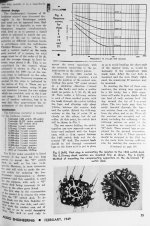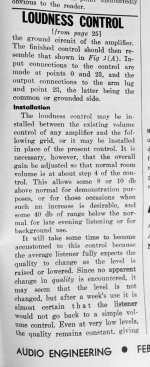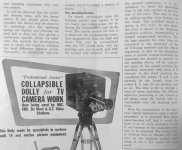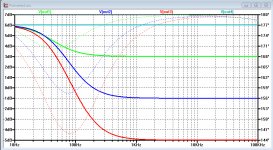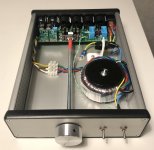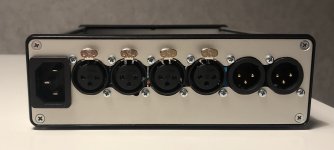A few late questions:
Hello,
I recently purchased some extra boards from another member, so coming very late to the party. Just now reading 90+ pages , plus the Hans Polak relay solution. A few questions:
, plus the Hans Polak relay solution. A few questions:
Hello,
I recently purchased some extra boards from another member, so coming very late to the party. Just now reading 90+ pages
 , plus the Hans Polak relay solution. A few questions:
, plus the Hans Polak relay solution. A few questions:- On another thread, in discussing Han's relay solution, mentioned that volume goes full when rotating the pot slowly. Isn't this kind of a fatal flaw, and have others experienced this?
- I think this preamp can accept single ended inputs, right? If so, on the output side, is a SE signal then converted to true balanced (opposite Vswings around central ground)?
Hi Anchan,
1) Not sure what you ask, but with an analog pot you can turn the gain to infinty, no matter what turning speed you use.
With a digital volume control the maximum gain is preset by resistors and can never be exceeded.
2) balanced and differential are two different annimals.
The output is balanced but not differential.
Driving the amp SE or Diff does not change anything to going balanced out.
Hans
1) Not sure what you ask, but with an analog pot you can turn the gain to infinty, no matter what turning speed you use.
With a digital volume control the maximum gain is preset by resistors and can never be exceeded.
2) balanced and differential are two different annimals.
The output is balanced but not differential.
Driving the amp SE or Diff does not change anything to going balanced out.
Hans
Hi Hans, thank for your kind response and all the work you've done on this board. To clarify:
1) I've read the whole thread and understand the infinite gain issue. I wonder if Bruno realizes that this one issue spawned 90+ pages of discussion lol. What I'm referring to is a glitch noted in the encoder + relays solution mentioned here, whereby due to the encoder itself, when turning slowly it induces an indeterminate state which outputs 1111 sending the output to max. I only noted one person mentioning this, so wanted to see if others have experienced it.
2) Ah yes, I've mixed up the two again. But you answered my question: balanced but not differential. I have an nCore amplifier module, and it works great sending an unbalanced or balanced signal to it. But I added a normal implementation of a pot on the unbalanced input, and it hella buzzes. There are not a lot of places I can see where a ground loop is being introduced. I did add an RC network at the RCA (100nF||100 ohms) as noted here (page 5/5) and that did help tremendously, but there is still a faint hum/buzz that's a bit annoying to me. I'm thinking that implementing a pot in the way Bruno outlines in this circuit will give the benefit of using a pot in conjunction with an unbalanced or balanced input.
3) While we're talking, let me ask one more question in regards your encoder/relay solution: Do you have an excel table or tool to figure out all the resistor values? As I understand the stock implementation is 16 positions @ 2db with the range of +6db/-24db. I use the volume more as a range selector rather than a super smooth volume knob, so in the case I want a 48db range in 3db increments to cover +14db/-34db (or something like that), how do I figure that out? Or I might go with +15db/-15db in 2db increments. Wondering how you figured out the math on your relay solution.
Thanks!
1) I've read the whole thread and understand the infinite gain issue. I wonder if Bruno realizes that this one issue spawned 90+ pages of discussion lol. What I'm referring to is a glitch noted in the encoder + relays solution mentioned here, whereby due to the encoder itself, when turning slowly it induces an indeterminate state which outputs 1111 sending the output to max. I only noted one person mentioning this, so wanted to see if others have experienced it.
2) Ah yes, I've mixed up the two again. But you answered my question: balanced but not differential. I have an nCore amplifier module, and it works great sending an unbalanced or balanced signal to it. But I added a normal implementation of a pot on the unbalanced input, and it hella buzzes. There are not a lot of places I can see where a ground loop is being introduced. I did add an RC network at the RCA (100nF||100 ohms) as noted here (page 5/5) and that did help tremendously, but there is still a faint hum/buzz that's a bit annoying to me. I'm thinking that implementing a pot in the way Bruno outlines in this circuit will give the benefit of using a pot in conjunction with an unbalanced or balanced input.
3) While we're talking, let me ask one more question in regards your encoder/relay solution: Do you have an excel table or tool to figure out all the resistor values? As I understand the stock implementation is 16 positions @ 2db with the range of +6db/-24db. I use the volume more as a range selector rather than a super smooth volume knob, so in the case I want a 48db range in 3db increments to cover +14db/-34db (or something like that), how do I figure that out? Or I might go with +15db/-15db in 2db increments. Wondering how you figured out the math on your relay solution.
Thanks!
Hi Anchan,
1) Not sure what you ask, but with an analog pot you can turn the gain to infinty, no matter what turning speed you use.
With a digital volume control the maximum gain is preset by resistors and can never be exceeded.
2) balanced and differential are two different annimals.
The output is balanced but not differential.
Driving the amp SE or Diff does not change anything to going balanced out.
Hans
Hi Anchan,
There is a simple manual operated version with 2^5 positions and one for use in combination with a remote control having 2^6 positions.
And yes, you can change the step size to any size you like.
When you send me a pm with your email address, I will send you the algorithm.
Hans
There is a simple manual operated version with 2^5 positions and one for use in combination with a remote control having 2^6 positions.
And yes, you can change the step size to any size you like.
When you send me a pm with your email address, I will send you the algorithm.
Hans
From reading and digesting most of this thread, it appears that I could use a log stepped attenuator, and this would preserve the channel matching of the original design, and allow efficient use of the dial. Is this correct? If so, does it matter which type of attenuator- ladder, series, or shunt? The Khozmo series and shunt are not too badly priced for a preamp of this caliber. Also, would the Goldpoint attenuators work? Getting a bit pricey, but still may be worth it.
It may be, but if I need resolution, then I'd have to step up to the 6 relay version, and may not have the space. Just understanding all my options, so the question is 50% academic too.
The 6 relay version of Han's board is very small (1x3 inches) and you can control it with a Arduino Nano, which is even smaller. You would need a 5V power supply, or you could use a 5V wallwart to power the Aurduino. I can't see it being an issue from a space perspective unless you are planning on using a very small case. Some people have mounted the 6relay board on a right angle header right at the edge of Bruno's board, so it would take almost no space.
Thanks for the response. Not sure why a direct response to my question in #986 about types of stepped attenuators is being avoided though. Is it a taboo question?
Curious if the Volume control board could have an attenuating response in accordance with Fletcher Munson curves. See the attached project below
Attachments
Just wondering: isn’t loudness control something of the past ?
No modern amp that I know of has such a provision, so there must be a valid reason for that.
But anyhow, I see no technical reason why you couldn’t implement a loudness variant for the BPBP.
Hans
No modern amp that I know of has such a provision, so there must be a valid reason for that.
But anyhow, I see no technical reason why you couldn’t implement a loudness variant for the BPBP.
Hans
Great to hear from you Hans.
I’ve been researching the SPL levels at the listening position at various mastering facilities; the research has included emailing specific facilities inquiring as to these levels. My most informative reply was:
Other [reading] research has borne this out as being a more or less conventional level among mastering professionals.
My understanding is that the Fletcher-Munson studies of equal loudness have not been overturned. There has been some efforts to further translate these findings into more precise applicability: Equal-Loudness Pressure Contours
Regardless of which is most applicable, it would seem that unless one is listening to material at a known reference mastering level, any attenuation of that level without compensation is perceptable as a decrease in frequency response below 1kHz to some varying degree.
I have your volume control PCB and would find it worthwhile to implement some capacities into the relay network (LSB to MSB) to attempt to compensate for this perceived low frequency drop with increased attenuation.
I welcome your thoughts on this and I appreciate your thoughtful contribution to this preamplifier.
Best regards.
I’ve been researching the SPL levels at the listening position at various mastering facilities; the research has included emailing specific facilities inquiring as to these levels. My most informative reply was:
We align our system using a pink noise signal though one of the 2 speakers at reference level. Adjust so that you measure 83 dB SPL (C-weighted, slow response) at the listening position (around 86 dB SPL with both speakers on).
Other [reading] research has borne this out as being a more or less conventional level among mastering professionals.
My understanding is that the Fletcher-Munson studies of equal loudness have not been overturned. There has been some efforts to further translate these findings into more precise applicability: Equal-Loudness Pressure Contours
Regardless of which is most applicable, it would seem that unless one is listening to material at a known reference mastering level, any attenuation of that level without compensation is perceptable as a decrease in frequency response below 1kHz to some varying degree.
I have your volume control PCB and would find it worthwhile to implement some capacities into the relay network (LSB to MSB) to attempt to compensate for this perceived low frequency drop with increased attenuation.
I welcome your thoughts on this and I appreciate your thoughtful contribution to this preamplifier.
Best regards.
By simply placing a 1H coil from pot input to the 2K resistor that goes to the opamp, I already get the result below.
When you experiment a bit, it should be quite easy to get your loudness control.
By making the coil switchable you can turn loudness on/off.
Hans
When you experiment a bit, it should be quite easy to get your loudness control.
By making the coil switchable you can turn loudness on/off.
Hans
Attachments
Finally about to assemble 8 BPBP powered via SJÖSTRÖM SSR03 Super Regs in a 16 channel volume control.
Any advice from the community welcome ... are there new better choices for OpAMP for example than the LM4562. I'm assuming no but thought I'd ask anyway.
cheers.
Any advice from the community welcome ... are there new better choices for OpAMP for example than the LM4562. I'm assuming no but thought I'd ask anyway.
cheers.
The LM4562 does an exellent job.
You could also consider an OPA1642 fet opamp.
If I may ask, why do you need so many channels, with high quality preamps ?
Hans
You could also consider an OPA1642 fet opamp.
If I may ask, why do you need so many channels, with high quality preamps ?
Hans
During the Xmas holidays I finished my build of the excellent BPBP. This will be serving in my lab eventually and also to work as a reference but now it is my only balanced pre amp. For the lab use I wanted it to be quite small and hence the small Hammond enclosure.
I had LDOVRs TPS7A4701 / TPS7A3301 regulators laying around so I used them. Otherwise a stock build.
The gain is way too high in my setup with the linear 10k pot so I’ll need to do something about it. Otherwise I’m a happy camper. 🙂
I had LDOVRs TPS7A4701 / TPS7A3301 regulators laying around so I used them. Otherwise a stock build.
The gain is way too high in my setup with the linear 10k pot so I’ll need to do something about it. Otherwise I’m a happy camper. 🙂
Attachments
- Home
- Source & Line
- Analog Line Level
- BPPBP - Bruno Putzey's Purist Balanced Preamp (well a balanced volume control really)

